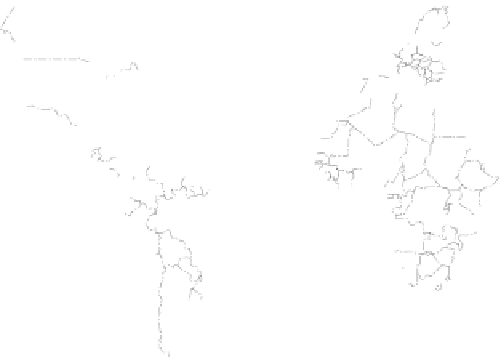Geography Reference
In-Depth Information
Arctic
Circl
e
6
0°
60°
ATLANTIC
PACIFIC
40°
40°
40°
40°
ATLANTIC
OCEAN
OCEAN
OCEAN
PACIFIC
20°
Tropic of Cancer
20°
20°
Tropic of Cancer
20°
OCEAN
INDIAN
OCEAN
0°
Equator
Equator
0°
ATLANTIC
20°
20°
20°
20°
20°
20°
20°
20°
Tropic of
Capricorn
Tropic of Capricorn
OCEAN
40°
40°
40°
40°
40°
40°
WORLD REGIONS OF PRIMARY
SUBSISTENCE AGRICULTURE
In the shaded areas, subsistence crop farming
is the l
eading way of
life. In an average year,
little surplus can be sold on markets.
160°
140°
120°
80°
60°
40°
0°
20°
40°
60°
100°
120°
140°
160°
60°
60°
60°
60°
60°
60°
60°
60°
Antarctic Circle
Figure 11.9
World Regions of Primarily Subsistence Agriculture.
Defi nitions of subsistence farming
vary. On this map, India and China are not shaded because farmers sell some produce at markets;
in Equatorial Africa and South America, subsistence farming allows little excess, and thus little
produce is sold at markets.
© E. H. Fouberg, A. B. Murphy, H. J. de Blij, and John Wiley & Sons, Inc.
change their livelihoods. In many cases, the state places
pressures on hunter-gatherers to settle in one place and
farm. Cyclical migration by hunter-gatherers does not
mesh well with bounded, territorial states. Some nongov-
ernmental organizations encourage settlement by digging
wells or building medical buildings, permanent houses, or
schools for hunter-gatherers. Even hunter-gatherers who
continue to use their knowledge of seeds, roots, fruits,
berries, insects, and animals to gather and trap the goods
they need for survival do so in the context of the world-
economy.
Unlike hunting and gathering, subsistence farming
continues to be a relatively common practice in Africa,
Middle America, tropical South America, and parts of
Southeast Asia (Fig. 11.9). The system of cultivation has
changed little over thousands of years. The term
subsis-
tence
can be used in the strictest sense of the word—that is,
to refer to farmers who grow food only to sustain them-
selves and their families, and fi nd building materials and
fi rewood in the natural environment, and who do not
enter into the cash economy at all. This defi nition fi ts
farmers in remote areas of South and Middle America,
Africa, and South and Southeast Asia. Yet many farm fam-
ilies living at the subsistence level sometimes sell a small
quantity of produce (perhaps to pay taxes). They are not
subsistence farmers in the strict sense, but the term
subsis-
tence
is surely applicable to societies where farmers with
small plots periodically sell a few pounds of grain on the
market but where poverty, indebtedness, and tenancy are
ways of life. For the indigenous peoples of the Amazon
Basin, the sedentary farmers of Africa's savanna areas, vil-
lagers in much of India, and peasants in Indonesia, subsis-
tence is not only a way of life but a state of mind.
Experience has taught farmers and their families that sub-
sistence farming is often precarious and that times of
comparative plenty will be followed by times of scarcity.
Subsistence farming has been in retreat for centu-
ries. From 1500 to 1950, European powers sought to
“modernize” the economies of their colonies by ending
subsistence farming and integrating farmers into colonial
systems of production and exchange. Sometimes their
methods were harsh: by demanding that farmers pay some
taxes, they forced subsistence farmers to begin selling
some of their produce to raise the necessary cash. They
also compelled many subsistence farmers to devote some
land to a crop to be sold on the world market such as cot-
ton, thus bringing them into the commercial economy.
The colonial powers encouraged commercial farming by
conducting soil surveys, building irrigation systems, and
establishing lending agencies that provided loans to farm-
ers. The colonial powers sought to make profi ts, yet it was
diffi cult to squeeze very much from subsistence-farming
areas. Forced cropping schemes were designed to solve
this problem. If farmers in a subsistence area cultivated a
certain acreage of, say, corn, they were required to grow a
specifi ed acreage of a cash crop as well. Whether this crop
would be grown on old land that was formerly used for
grain or on newly cleared land was the farmers' decision.
If no new lands were available, the farmers would have to
give up food crops for the compulsory cash crops. In many



































































































































































































































































































































































































































































































































































































































































